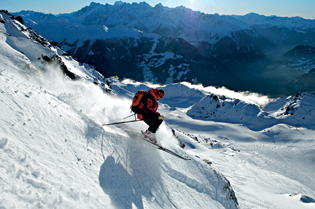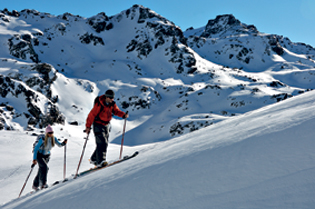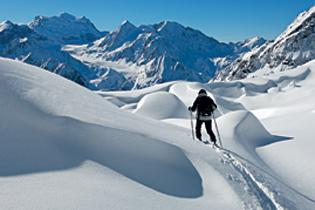


Escapades in the hinterland of Val de Bagnes
The pleasures of powdery snow
The hinterland of Val de Bagnes and the Quatre Vallées provides a fine range of pleasures to those who want to discover the area in their ski tips. And it’s not just for show…
TEXT & PHOTOS : François Perraudin
The reputation of Verbier's off-piste sections still continues to attract more top level sportsmen, all fans of powdery snow and thrilling conditions. The Creblet, the Col des Mines and the Vallon d'Arby are quickly transformed into bumpy pistes and the initial tracks close to the ski lifts sometimes call for prudence on the downhill sections.
In the company of guides, it is possible to put on seal skins and escape this dangerous frenzy. This is as much a precautionary measure as a desire to track down some less frequented playing fields. You have to get up early and walk for at least two hours to reach the somewhat preserved slopes. Fantastically served by Tortin, Mont-Gel and Mont-Fort, the skiable domain of Verbier and Quatre Valles offers a profusion of variation and surprises, spiced up by the vagaries of the snow and the whims of the weather, guarantors of a constantly changing horizon.
Even marked out, itineraries require a good sense of direction. Indeed, there are as many wrong tracks as right ones, and sometimes these can be very dangerous, because they may have been created by thrill seekers who are not afraid of making huge cliff jumps. A track created a few hours earlier can be dangerous once the sun or wind have cruelly undermined the route. Added to that is the peril of a sea of fog enveloping what was clear terrain minutes earlier and creating confusion.
Prudence
It is worth remembering that nothing can replace caution, or even experience: Without them a DVA, probe, shovel, Airbag or Avalung will not be much help. With or without preventative material an avalanche goes where it likes, when it likes, and its snowy mantel conceals almost everything. For novices, the first precautionary measure remains being accompanied by a guide or an experienced and trusted person. Indeed the former is also a guarantee of enjoyment. You shouldnŐt think twice about giving up if it isnŐt the right day. The mountain will still be there, the snow will become stable and there may even be a new layer of snow... Your appetite whetted by your patience, your satisfaction will only be increased!
Beautifully exposed to the sun, the slopes of Marlnaz provide a vast terrain for expression. It is also a beautiful, varied space that a number of those familiar with the area regularly climb in their skins, without risking too much if they set out early. In the spring, beware of the powdery snow which becomes heavy from noon onwards.
At 1hr30mins from the summit, the Bruson facilities on the north-east slope of the Tte de la Payanne provide some fine downhill sections towards Bruson, through a forest which narrows towards the centre. At the far end is the hinterland of the Haut Val de Bagnes, where a few steep descents can be made in late spring at Mont Pleureur (3,703m) or Tournelon Blanc (3,700m): ascents and descents are reserved for experienced mountain skiers!
In the 80s, you could open the great couloir of Mont-Gel, admire your tracks from the tram and then trace a "figure eight" which remains untouched... until the following day! You now search for the slightest hint of a virgin slope here, but the enjoyment remains the same, below the Attelas, with the resort of Verbier and the Dents du Midi in the distance.
After snowfall accompanied by wind, or in the event of heavy snow in spring, traversing the S face of Mont-Fort is too dangerous to access the couloirs of the E face. We can approach the Lac du Petit Mont-Fort via the ŇPetite Face S" which leads behind the Col de la Chaux (2,941m) and even drops back down via the piste to the Col des Gentianes and joins up with the foot of the same col. This itinerary extends the walk to Rosablanche by 1hr30mins.
The summit of the Rosablanche (3,330m) can be reached in 2 to 3h30mins from the starting point. In the background you can see the Combins massif. The northern slopes of the Grand Dsert glacier, towards the Cleuson dam, provide the safest descents. Fans of the Haute Route opt for the short but beautiful descent across to the Prafleuri refuge. The descent of the Vallon de Sovereu can be tackled via a SWŐly slope at the summit which is subject to wind slabs.
Behind the Col de la Chaux, the Lac du Petit Mont-Fort region is an area lots of excursions set out from, in the hinterland of Haut Val de Bagnes, combined with the jewel of the Combins. Exiting the Louvie valley across Fionnay is clearly discouraged. The Sovereu valley is preferable as its final steep couloir is often levelled off by snow slides... provided that you are not there when the latter decide to drop down!
The east faces of the Mont-Fort and the Grand Dsert glacier provide a vast training ground. From left to right you can see slopes leading to the Fentre dŐAllves (descent across Pralong in the Val d'Herens, returning via the Quatre Valles), the fabulous N slopes of Mont Calme, which conceal the gateway to Rosablanche, the Grand Combin in the background, the Col du Meitin opening onto the vast terrain of the Grand Dsert glacier and the many variants to the rear of Mont-Fort. Far over to the right are the NE avalanche-prone slopes of the Arpette, that too many reckless climbers traverse to avoid going along the right hand shore of the Cleuson lake.
Lisez la suite de l'article dans le magazine Mountain Report - Oů le trouver ?

